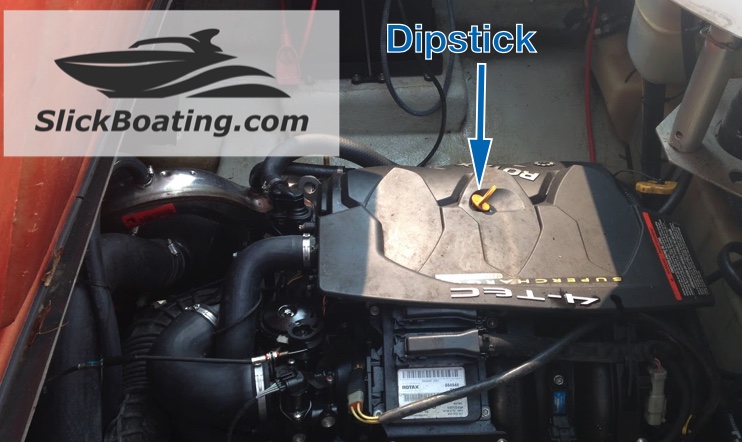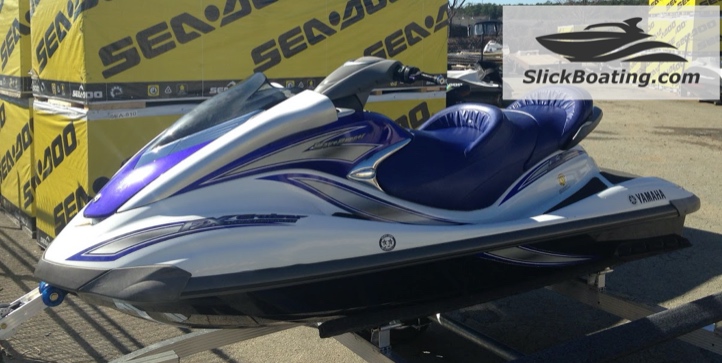Buying a used jet ski is very different than buying a new jet ski.
You have to worry about how well the previous owner took care of the jet ski. Did they do proper service, was it sunk, does it have too many hours, and many other factors to consider.
After buying and owning several jet skis, here are the biggest tips I can give.
1. Say No To 2-Stroke Engines
I’ve gotten some flack from readers when I say people should avoid 2-stroke jet skis, but the last new 2-stroke sit-down jet ski was made in 2007.
Jet ski manufacturers only build 2 strokes to last for 10 years, and as of writing this, we’re way beyond 10 years from 2007.
If you’re not sure the jet ski you’re looking at is a 2-stroke or not, just look for a dipstick.

Only 4-strokes, the jet skis you get today, will have a dipstick. A 2-stroke burns its oil, so there is no need for a dipstick.
Not only are 2-strokes obsolete, but they burn more gas and pollute the water a lot more than a 4-stroke. 2-strokes are so bad that many lakes have banned them.
It’s best to avoid 2-strokes at all costs.
2. Check Hours
I have an entire post where I talk about jet ski hours and what is too many here.
To give you an idea, an average jet ski rider will put 30 hours a year on their jet ski.
So if you’re looking at a jet ski that is 5 years old, I would expect it to have 150 hours. If it’s a little more at 175, I don’t panic, but if it’s over 200, I start to worry.
The opposite is true too. A 5-year-old jet ski that is under 100 hours or better yet under 50 hours will have me worried. They either didn’t use it much, or it was a lemon, and they never rode it because of that.
It’s the extremes that I worry about when it comes to jet ski hours. Too much and too little, other than that, I don’t care about jet ski hours.
I do like seeing someone with a lot of hours and have done the yearly services religiously. If someone is willing to put a lot of hours on a jet ski, it means they enjoyed it, and it didn’t give them much trouble – I want that machine.
3. Don’t Buy Unless You Water Test!
I’ve seen so many people get burned because they did not water test the jet ski before paying for it.
And don’t fall for the “I can run it on the garden hose” scam either. Running a jet ski on the hose is not the same as taking it to the water.
You need to get the watercraft on the water and go full throttle and see if there is any hesitation. Even the slowest jet skis will feel fast and want to launch out of the water.
You also want to float a bit to see if the jet ski is taking on water. I usually do this with half the jet ski sticking off the trailer while the other end floats in the water. I take off the seat and sit there for a minute, looking and listening for any water coming into the hull. And when I get back from my test ride, I look again because water can find its way in with the engine running.
After running it’s normal to see a cup or two of water in the bottom of the hull. Any more than that and I worry.
I also check the brakes and reverse if the jet ski has it.
A simple water test can reveal a lot about a jet ski, but it can be hard to do. Some sellers don’t want to do it because they don’t want you to steal or break it. But there is no better way to test a jet ski than to get it on the water.
4. Check The Supercharger
If you want to go as fast as possible, then a jet ski with a supercharger is your only option.
Once you start to get above 200HP, all models from every manufacturer will have a supercharger.
The problem with superchargers is that its extra maintenance and cost. I’ve gotten to the point where I’ve gone fast enough and usually stay away from supercharged models. Everyone is not like me and have the need for speed.
So if you get a supercharged model, you should check it for any issues if you can.
You also need to see when or if the supercharger needs to be serviced.
The good news is that a supercharger rebuild is something you’ll do once maybe twice on the life of the jet ski. If you put a lot of hours on your jet ski, it might be 3 or 4, but I’ve rarely seen that.
Supercharger rebuilds are not cheap; many places are doing them for $1k plus. Keep that in mind when haggling if the jet ski needs it soon (in 30 hours).
5. Check The Engine
There are a few things to check when it comes to a jet ski engine.
Check COMPRESSION
A compression test is a simple and fast way to see if the engine is still good. The problem is that it needs special tools. Amazon sells compression testers here (ad).
When checking compression, you want the PSI to be above 100, but more importantly, you want all cylinders to be within 15% of each other.
So if you check all 3 cylinders and you get 130, 135, 130, that is fine. It’s when you get 130, 180, 110 that it becomes an issue. Those 3 numbers are not close to each and have me worried. If one cylinder gives you an odd reading, then check again or use a different gauge.
Check Oil
Pull the dipstick out and use a clean white rag to check the color of the oil.
- Solid black = needs to be changed.
- Dark Amber = just changed.
- Looking like a melted frosty milkshake = water in the engine, which is very bad.
Motor oil color guide here.
What you want to focus on the most is if the oil looks like a melted chocolate milkshake. This means the engine has water in it, and you should run away. This jet ski was sunken, or something seriously bad happened to it, and the seller is trying to make it go away.
The oil that looks black is normal after running it for a few weeks. If the oil is amber in color, then it was changed very recently.
If the previous owner can’t tell you when the last time the oil was changed, you should change it anyway. I’ve seen people who never changed the oil in a jet ski. I find it better to assume they never changed the oil, and I change it anyway when I first get it home.
Check The Battery
Just like the oil, I assume the previous owner never changed the battery, so I get a new one.
A battery is an easy thing to change, and something super important. A dead or weak battery can leave you stranded, so I replace them anyway.
You can expect to change your battery every 3 to 5 years so long as you keep it on charge when you’re not using it. I use a solar panel charger to keep my batteries charged on my boats. Stick to 5 watts or less.
Check For Rust
If you see paint flaking off the engine and a lot of rust in the engine compartment, this often means the jet ski was exposed to a lot of saltwater.
It also means the previous owner didn’t take the proper steps to protect the engine and components from rust.
The problem with rust is when it comes to electrical components. Rust makes electronics either not work or act funny.
6. Check The Price
The biggest question you probably have is how much should you pay for a used jet ski?
The good news is that KBB has a watercraft section here that can give you an idea of price.
Keep in mind that prices for used jet skis fluctuate according to the season. You can get a better deal during the winter but expect to pay more during the summer.
Buy from Dealer or Private?
When talking about price, one question I get is if it’s better to buy from a dealer or a private seller.
It doesn’t matter too much.
A dealer has more to lose in selling you something bad and would be more willing to do test drives.
But you might get a better deal on a private seller because the seller doesn’t understand what they have or just wants to get rid of it.
No joke, I got a great deal on a jet ski that would typically go for $8k and got it for $6k because he was moving to a different state and did not want the hassle of hauling it. While these types of deals are rare they do exist. and only in private sales.
7. Check The Trailer
I don’t know why more websites don’t talk about checking the jet ski trailer, but it’s kind of a big deal.
Every trailer I’ve dealt with or seen is neglected. I’ve yet to meet someone who took care of the trailer properly.
You need to check the tires to make sure they’re not dry rotting, and if they are, you’re looking at about $150 for a replacement on a good 15-inch rim.
You need to ask when the last time they greased the bearings. Here is how you grease trailer wheel bearings.
Then you need to check the lights. Most people never check their trailer lights until a cop pulls them over. You need to make sure the brake light and turn signals work for both sides of the trailer.
The safety chains need to be checked too. You need two of them, and both need to be used and crossed. Here is how you handle safety chains for trailers.
Lastly, check for any damage on the trailer. Check the frame for any rust or splits as this is a bad thing.
8. Get It Checked Out By Your Local Dealer
I know many don’t want to get the jet ski dealer involved because it can be a hassle, but they’re the only ones who can spot all the problems from a mile away for your particular situation.
Even if you don’t take it to the dealership to get checked out at least get the VIN and see if there are any outstanding warranty issues. This also is a great way to find out if the jet ski is stolen or not.
Asking random people on the internet if this or that jet ski is worth it is not as good as having a tech looking at it in person. The dealership tech will know what to look for and give you an honest opinion because it’s not their jet ski they’re trying to sell.
